Getting started
This chapter helps you to install and run MuseScore for the first time. The chapter will also show you how to create a new score.
Instal·lació
MuseScore funciona en diferents sistemes operatius incloent Windows, Mac OS X i Linux.
Windows
Instal·lació
Pots aconseguir l'instal·lador per a Windows a la pàgina de Nonexistant node nid: 27 del web de MuseScore. Prem a l'enllaç per iniciar la baixada. El navegador et preguntarà si de veritat vols baixar-ho. Prem Desa el fitxer.
When the download finishes, double-click on the file to start the installation. Windows may prompt you with a security window to confirm this before running the software. Click Run to continue, you'll then briefly see
NOT FOUND: Win-Install-Wizard-1a.png
followed by
NOT FOUND: Win-Install-Wizard-1b.png
In case you don't see this installer window but something else, it's possible that the .msi extension is not associated with msiexec.exe. Either you can fix the association, or download and use the portable version of MuseScore instead.
Continuing you'll see
NOT FOUND: Win-Install-Wizard-1c.png
If you click Cancel, here or later, you'll see:
NOT FOUND: Win-Install-Wizard-2a.png
If instead you click Next to continue, the setup wizard displays the terms of the free software license.
NOT FOUND: Win-Install-Wizard-2b.png
Make sure the I accept the terms in the License Agreement is ticked and click Next to continue. Next it confirms the location for installing MuseScore.
NOT FOUND: Win-Install-Wizard-3.png
If you are installing a newer version of MuseScore but still want to keep the old version on your computer, then you should change the folder (version 2.0 and 1.x can coexist and don't overwrite one another, so no changes needed for those). Otherwise click Next to continue.
NOT FOUND: Win-Install-Wizard-4.png
Click Install to continue.
Give the setup wizard a few minutes to install the necessary files and configurations. You'll see
NOT FOUND: Win-Install-Wizard-5a.png
then
NOT FOUND: Win-Install-Wizard-5b.png
and finally
NOT FOUND: Win-Install-Wizard-5c.png
Click Finish to exit the installer. You may delete the installer file you downloaded.
Start MuseScore
To start MuseScore choose Start → All Programs → MuseScore 2 → MuseScore 2.
Uninstall
You can uninstall on 32-bit Windows with
cd C:\Program Files\MuseScore
Uninstall.exe /S
and on 64-bit Windows with
cd C:\Program Files (x86)\MuseScore
Uninstall.exe /S
Troubleshooting
On Windows XP and Vista, the installer might be blocked by the system. If you don't manage to install MuseScore, right click the downloaded file and click Properties. If there is a message "This file came from another computer and might be blocked to help protect this computer", click on "Unblock", "OK" and double click on the downloaded file again.
Mac OS X
Install
You will find the DMG file on the Nonexistant node nid: 27 page of the MuseScore website. Click on the link to start the download.
NOT FOUND: Mac_Install.png
- Drag and drop the MuseScore icon to the Applications folder icon. If you are not logged in as administrator, Mac OS X may ask for a password: click Authenticate and enter your password to proceed.
- You can now launch MuseScore from the Applications folder, Spotlight, or Launchpad.
Uninstall
Simply delete MuseScore from Applications folder.
Linux
Please see the Nonexistant node nid: 27 page for instructions pertaining to MuseScore on Linux. Packages are provided for Debian, Ubuntu, Fedora and PCLinuxOS. Other distributions will require you to build the application from source. For instructions specific to Fedora, see below.
Fedora
-
Import the GPG key:
su rpm --import http://prereleases.musescore.org/linux/Fedora/RPM-GPG-KEY-Seve -
Go to the Nonexistant node nid: 27 page of the MuseScore website. Click on the link for the stable Fedora download and choose the correct rpm package for your architecture.
-
Depending on your architecture, use one of the two sets of commands to install MuseScore
-
for arch i386
su yum localinstall musescore-X.Y-1.fc10.i386.rpm -
for arch x86_64
su yum localinstall musescore-X.Y-1.fc10.x86_64.rpm
-
If you have difficulty with sound, see Fedora 11 and sound
See also
- How to change the language in MuseScore
- How to install MuseScore on Windows without administrator rights
- How to run MuseScore as Administrator on Windows
Install on Windows
Install
If you're on Windows 10, MuseScore can be installed from the Windows Store. Clicking here will open Musescore's page in the Store app. There you will only have to click Get the app > and MuseScore will be downloaded and installed.
Otherwise you can get the Windows installer from the download page of the MuseScore website. Click on the link to start the download. Your Internet browser will ask you to confirm that you want to download this file. Click Save File.
When the download finishes, double-click on the file to start the installation. Windows may prompt you with a security window to confirm this before running the software. Click Run to continue, you'll then briefly see
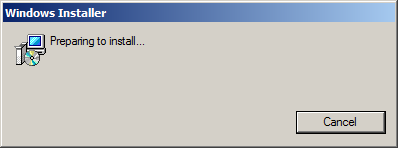
followed by
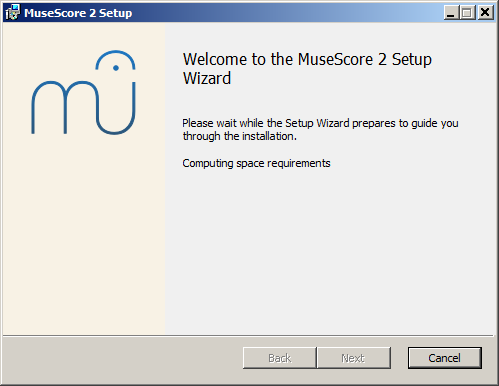
In case you don't see this installer window but something else, it's possible that the .msi extension is not associated with msiexec.exe. Either you can fix the association, or download and use the portable version of MuseScore instead.
Continuing you'll see

If you click Cancel, here or later, you'll see:
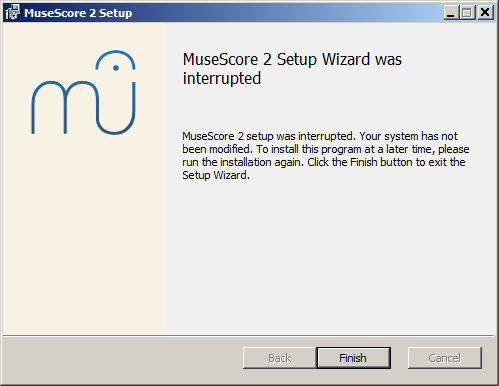
If instead you click Next to continue, the setup wizard displays the terms of the free software license.
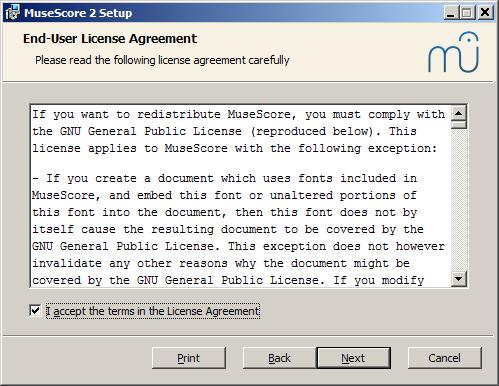
Read the terms of the license, make sure the box next to "I accept the terms in the License Agreement" is checked, and click Next to continue. Next the installer will ask you to confirm the location in which to install MuseScore.
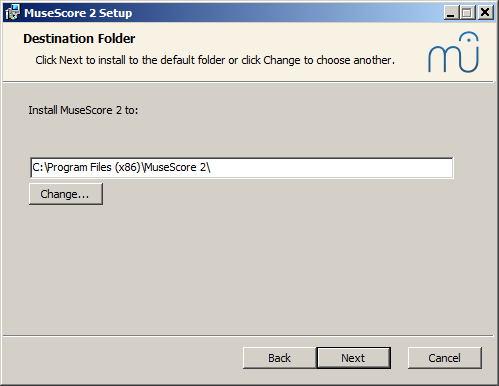
If you are installing a newer version of MuseScore but still want to keep the old version on your computer, then you should change the folder (note that MuseScore 2 can coexist with MuseScore 1 with no changes needed). Otherwise click Next to continue.
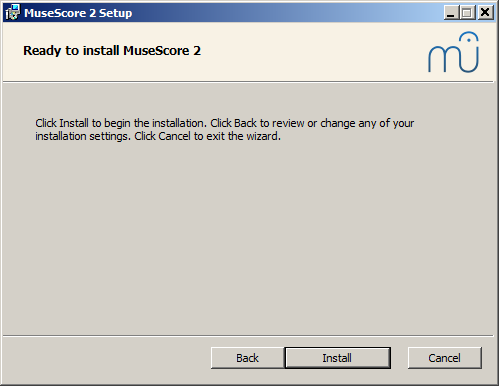
Click Install to continue.
Give the setup wizard a few minutes to install the necessary files and configurations. You'll see

and finally
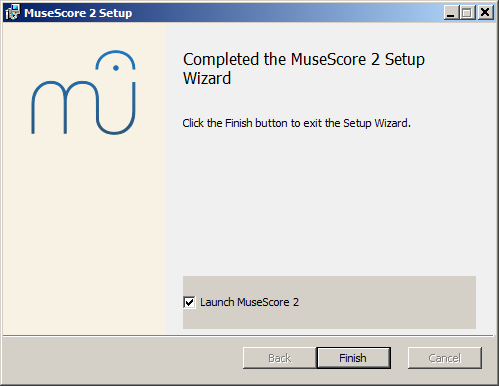
Click Finish to exit the installer. You may delete the installer file you downloaded.
Start MuseScore
To start MuseScore, from the menu, select Start→All Programs→MuseScore 2→MuseScore 2.
Uninstall
You can uninstall MuseScore from the menu by selecting Start→All Programs→MuseScore 2→Uninstall MuseScore; or via Windows' Control Panel. Note that this will not remove your scores nor your MuseScore settings.
Troubleshooting
On Windows XP and Vista, the installer might be blocked by the system. If you don't manage to install MuseScore, right click the downloaded file and click Properties. If there is a message "This file came from another computer and might be blocked to help protect this computer", click on "Unblock", "OK" and double click on the downloaded file again.
External links
Install on macOS
Install
You will find the DMG (disk image) file on the download page of the MuseScore website. Click on the macOS link to start the download. When the download is complete, double-click the DMG file to mount the disk image.
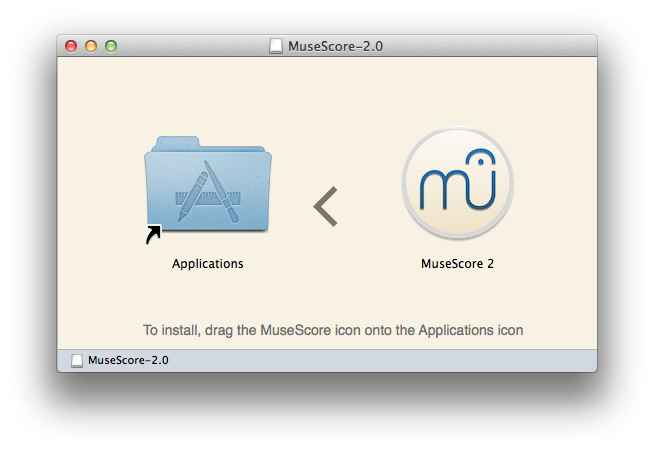
Drag and drop the MuseScore icon to the Applications folder icon.
If you are not logged in as administrator, macOS may ask for a password: click Authenticate and enter your password to proceed.
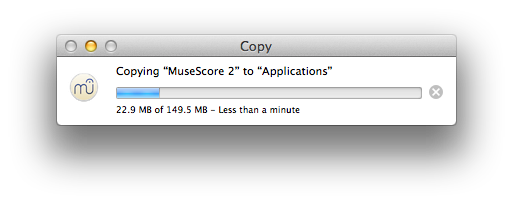
When the application has finished copying, eject the disk image. You can now launch MuseScore from the Applications folder, Spotlight, or Launchpad.
Uninstall
Simply delete MuseScore from Applications folder.
Install with Apple Remote Desktop
You can deploy MuseScore to multiple computers with the "Copy" feature of ARD. Since MuseScore is a self-contained application you can simply copy the application to the '/Application' folder on the target machines. It is also possible to install multiple versions of the application as long as their names differ.
External links
Install on Linux
As of MuseScore 2.0.3 you can, for the first time, get hold of a copy for Linux straight from the download page, just like Windows and Mac users. This is possible thanks to the AppImage packaging format, which runs on pretty much all Linux distributions. If you prefer, there is still the option to get it the traditional way via your distribution's package manager (but you may have to wait for it to get packaged by the relevant maintainer). Of course, you can always build from source.
AppImage
The AppImage format is a new way of packaging Linux applications. AppImages are portable - they don't have to be installed - and they run on pretty much any Linux distribution. Dependencies are included in the one AppImage file.
Step 1 - Download
Before you download an AppImage, you need to know your processor's architecture. These terminal commands will show it:
archor
uname -m
The output will be something like "i686", "x86_64" or "armv7":
i686(or similar) - 32-bit Intel/AMD processor (found on older machines).x86_64(or similar) - 64-bit Intel/AMD processor (modern laptop and desktop computers, most Chromebooks).armv7(or later) - ARM processor (phones & tablets, Raspberry Pi 2/3 running Ubuntu Mate, some Chromebooks, usually 32-bit at present).
Now you can head over to the download page and find the AppImage that best matches your architecture. Once downloaded, the file will be named "MuseScore-X.Y.Z-$(arch).AppImage".
Step 2 - Give execute permission
Before you can use the AppImage you need to give permission for it to be run as a program.
From the Terminal:
This command gives the user (u) permission to execute (x) the AppImage. It works on all Linux systems.
cd ~/Downloads chmod u+x MuseScore*.AppImage
Note: Use the "cd" command to change directory to wherever you saved the AppImage.
From a File Manager:
If you prefer to avoid the command line, there is usually a way give execute permission from inside a File Manager.
In GNOME Files (Nautilus), simply:
- Right-click on the AppImage and select "Properties".
- Open the "Permissions" tab.
- Enable the option labelled "Allow executing file as a program".
The process may be slightly different in other file managers.
Step 3 - Run it!
Now you should be able to run the program simply by double-clicking on it!
When you downloaded the AppImage it was probably saved in your Downloads folder, but you can move somewhere else it at any time (e.g. you could put it on your desktop for easy access). If you ever want to remove it then simply delete it.
Installing the AppImage (optional)
You can run the AppImage without installing it, but you must install it if you want it to be completely integrated with your desktop environment. This has the following benefits:
- Adds the AppImage to your Applications Menu or Launcher
- Sets the correct icons for MuseScore's files (MSCZ, MSCX) and for MusicXML files (MXL, XML)
- Makes the AppImage available via your File Manager's right-click "Open with..." menu
To install it, run the AppImage from the Terminal with the "install" option (see immediately below). This copies a desktop file and various icons to your computer. If you want to remove them you will need to run the "remove" option before you delete the AppImage. This does not affect any scores created with any version of MuseScore.
Using command line options
Running the AppImage from the Terminal allows you to use various command line options. The AppImage has some special options in addition to MuseScore's normal command line options.
You will need to change directory (cd) to wherever the AppImage is saved your system, for example:
cd ~/Desktop ./MuseScore*.AppImage [option...]
Or give the path to the AppImage:
~/desktop/MuseScore*.AppImage [option...]
Use the "--help" and "man" options to get more information about the available command line options:
./MuseScore*.AppImage --help # displays a complete list of command line options ./MuseScore*.AppImage man # displays the manual page (explains what the options do)
Distribution Packages
Fedora
-
Import the GPG key:
su rpm --import http://prereleases.musescore.org/linux/Fedora/RPM-GPG-KEY-Seve
-
Go to the download page of the MuseScore website. Click on the link for the stable Fedora download and choose the correct rpm package for your architecture.
-
Depending on your architecture, use one of the two sets of commands to install MuseScore
-
for arch i386
su yum localinstall musescore-X.Y-1.fc10.i386.rpm
-
for arch x86_64
su yum localinstall musescore-X.Y-1.fc10.x86_64.rpm
-
If you have difficulty with sound, see Fedora 11 and sound.
See also the hints for the various distributions on the download page.
External links
Install on Chromebook
Desktop program
MuseScore's desktop program will not work natively on Chrome OS, but there are some workaround solutions:
-
Since Chrome OS 69, certain chromebook models are able to run Linux apps and so you can install MuseScore for Linux as provided on our Download page. Feedback about the installation process and supported hardware is welcome on the forum
-
Via software-on-demand service such as rollApp: By just visiting this website, you can run MuseScore in the browser. You can access your scores via cloud services such as Google Drive or save them to your online MuseScore account through the menu File→Save Online.... Note that currently, sound and playback does not work on rollApp.
-
Via Crouton: Involves installing a Linux based operating system which runs in parallel with Chrome OS, and then installing MuseScore on Linux.
Android app (playback only)
Alternatively, it is possible to install MuseScore's Android app on recent Chromebooks. You will need to update to the latest version of Chrome OS first. See the Chromebook support documentation for help installing Android apps on Chromebooks, and a list of supported devices. The app only supports playback of existing scores, not score editing or creation, but you can sign-in to your MuseScore account for easy access to all your scores on MuseScore.com.
External links
- How to run MuseScore on a Chromebook
- Check the installation procedure from the comments in this thread
- How to change the language in MuseScore
Language settings and translation updates
MuseScore will be installed and work with your "System" language (the one used for most programs, and generally depending on your country and the language settings of the PC, or account).
Change language
- From the menu, select Edit→Preferences... (Mac: MuseScore→Preferences...);
-
In the General tab, select the desired language from the drop-down list in the Language section:
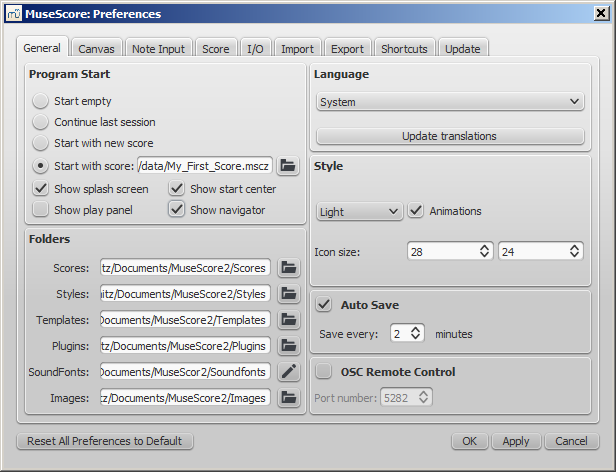
-
To update translations, click on the Update translations button. Then click on the Update buttons for the languages you want to update (for an alternative method, see below).
As then indicated, you will have to exit and reopen MuseScore for changes and updates to take effect.
Update translation
You can update the translation as explained above, via the preferences settings, but there is another method:
- From the menu, select Help→Resource Manager;
-
Click on the Update buttons for the languages you want to update.
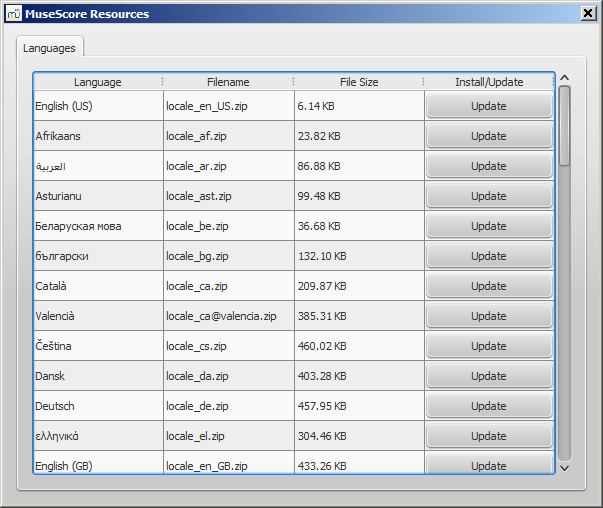
Here too you will have to exit and reopen MuseScore for the update to take effect.
See also
External links
Checking for updates
There are two ways to check for updates.
Automated update check
- From the menu, select Edit→Preferences... (Mac: MuseScore→Preferences...);
- Select the Update tab:
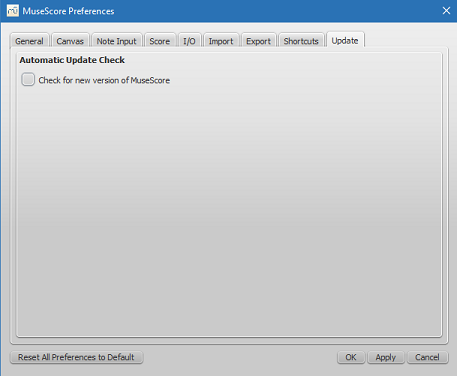
- Tick the box marked "Check for new version of MuseScore."
Now MuseScore will check for updates on every start and notify you, if need be.
Check for update
- From the menu, select Help→Check for Update:
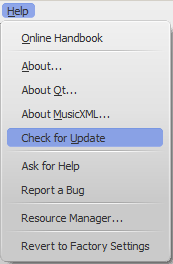
- A dialog will appear with the update status: either "No Update Available" or "An update for MuseScore is available:" followed by a link to download it.
Note: These options are only available in the Mac and Windows versions of MuseScore (except the version from the Windows Store), as only those can be updated directly from MuseScore.org. Linux distributions (and the Windows Store) have different mechanisms to make updates available.